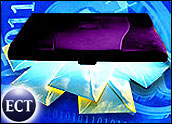
The number one and number two semiconductor manufacturers, Intel and AMD, both cited reduced PC demand and weak back-to-school sales this week as they reported third-quarter earnings that fell short of analysts’ expectations.
AMD proved to be one of the biggest surprises this earnings season, with a US$254 million loss on $508.2 million in sales revenue. Those results represent a 34 percent decline from the previous year’s $765.9 million in sales. AMD also reported a smaller loss of $187 million a year ago.
Analysts surveyed by Thomson First Call had expected AMD to lose about $230 million on sales of $499.7 million.
On Intel’s Heels
Earlier this week, Intel booked third-quarter revenue of $6.5 billion, nearly flat with last year’s $6.55 billion, halting a marketwide rally that had been ongoing for four days.
“Although the industry is experiencing one of its worst downturns ever, we continue to move our technology forward,” Intel CEO Craig R. Barrett said. “Going forward, we remain committed to investments in new products and technologies, setting the stage for us to emerge even stronger when the economy and demand recover.”
PC Chips Fall as Others Rise
AMD pointed to strong chip sales for servers, mobile devices and flash memory, and said its progress in those areas was masked by continued losses in the PC market.
“We will begin to implement additional and aggressive actions in the fourth quarter that are expected to significantly reduce our quarterly breakeven point beginning in the first quarter of 2003,” said Robert J. Rivet, AMD’s chief financial officer.
Intel also noted that third-quarter shipments of chipsets, flash memory and Ethernet connectivity product units were higher than in the previous quarter, while it also released 18 new microprocessors and 11 mobile processors.
Mobile Bright Spot
IDC senior semiconductor analyst Shane Rau told the E-Commerce Times that the area offering the most growth potential for chipmakers is mobile chips.
“I think companies are surprised over and over again about how conservative end users are being in their purchasing,” Rau said. “We’ve known for a long time that corporations have been very conservative on their IT budgets and how much they spend on things like PCs.”
Holiday Sales Hazy
While holiday sales are traditionally among the strongest for chip manufacturers, sales this season are not forecast to equal previous increases of nearly 20 percent. Intel said it expects fourth-quarter sales to be between $6.5 billion and $6.9 billion — marginally higher than in the third quarter.
Last month, IDC cut its worldwide PC buying forecast for consumer and business sectors for the remainder of 2002 to a meager 1.1 percent growth, down from the company’s original 4.7 percent forecast earlier in the year.
To combat the downturn, Rau anticipated that chip companies will respond with slashed prices.
“There’s going to be a lot of pressure on prices through the fourth quarter because companies like Intel not only have competitive issues to deal with, but overall market issues,” he said. “Intel and other companies will be cutting prices in order to simulate overall growth of PCs, as well as simply maintain their sales of chips.”












































Social Media
See all Social Media